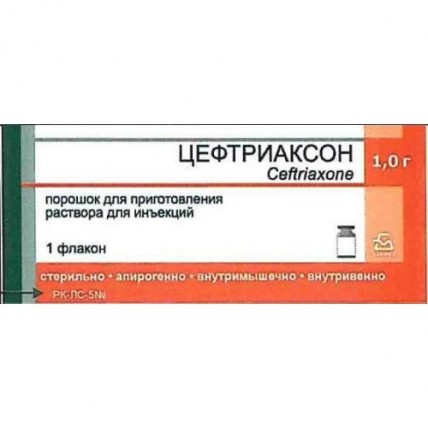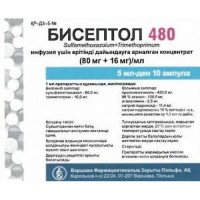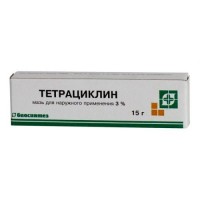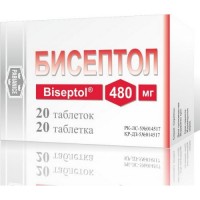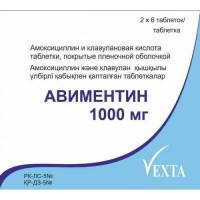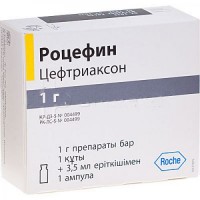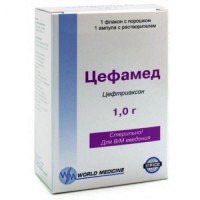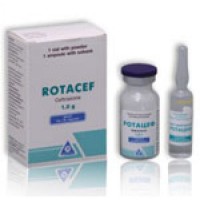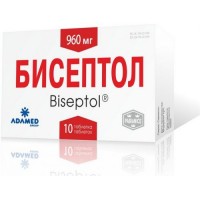Ceftriaxone 1g 1's powder for solution for injection
- $4.00
The instruction for medical use of Tseftriakson Torgovoye medicine a name Tseftriakson Mezhdunarodnoye the unlicensed name Tseftriakson Lekarstvennaya a form Powder for preparation of solution for injections of 0.5 g and 1.0 g Structure contains One bottle: active agent – tseftriakson (in the form of a tseftriakson of sodium salt) – 0.5 g or 1.0 g the Description crystal powder, White or white with a yellowish shade. Pharmacotherapeutic group Antimicrobial drugs for system use. Antibacterial drugs for system use. Beta laktamnye antibacterial drugs other. Cephalosporins of the third generation. Tseftriakson. The ATX J01DD04 code the Pharmacological Pharmacokinetics Pharmacokinetics properties of a tseftriakson has nonlinear character. All key pharmacokinetic parameters based on the general concentration of drug except for elimination half-life, depend on a dose. Intramuscular introduction After an intramuscular injection the average level of concentration of a tseftriakson in plasma is approximately twice lower, than at intravenous administration of an equivalent dose. The maximum concentration in blood plasma after single intramuscular introduction of 1 g of drug makes 81 mg/l and is reached in 2-3 h after introduction. The areas under curves time concentration in blood plasma after intravenous and intramuscular administration are identical. It means that the bioavailability of a tseftriakson after intramuscular introduction is 100%. Intravenous to a vvedeniyeposla of intravenous administration of a tseftriakson of 500 mg and 1 g the average peak of a tseftriakson in plasma of a tseftriakson makes about 120 mg/l and 200 mg/l respectively. After intravenous administration of a tseftriakson of 500 mg, 1 g and 2 g, concentration of a tseftriakson in plasma make about 80 mg/l, 150 mg/l and 250 mg/l respectively. Distribution. The volume of distribution of a tseftriakson is 7-12 l. Concentration much above the minimum inhibiting concentration concerning the most significant activators are found in fabrics, including lungs, heart, bilious ways / a liver, tonsils, a middle ear and a mucous membrane of a nose, a bone and in cerebrospinal fluid, pleural, prostatic and synovial fluid. At repeated introduction the increase in average peak concentration (Cmax) by 8-15% is observed. The stable state is reached in most cases during 48-72 h depending on a way of introduction. Penetration into separate fabrics. Tseftriakson gets through a meninx. The permeability of a meninx for a tseftriakson is maximum when they are inflamed. In bacterial meningitis the average concentration of a tseftriakson in cerebrospinal liquid makes 25% of concentration in blood plasma, in the absence of meningitis - 2%. The peak of concentration of a tseftriakson in cerebrospinal fluid is reached approximately in 4-6 hours after intravenous administration. Tseftriakson gets through a placental barrier and is allocated in breast milk in low concentration. Linking with proteins. Tseftriakson reversibly contacts albumine, and extent of binding decreases with concentration growth, for example, decreasing from 95% at concentration in blood plasma less than 100 mg/l to 85% at concentration of 300 mg/l. Metabolism. Tseftriakson is not exposed to system metabolism, and turns into inactive metabolites under the influence of indestinal flora. Removal. The general clearance of a tseftriakson is 10-22 ml/min. The renal clearance is equal to 5-12 ml/min. of 50-60% of a tseftriakson also 40-50% are removed in not changed look by kidneys - in not changed view with bile. Elimination half-life of a tseftriakson at adults makes about 8 hours. Pharmacokinetics in special clinical cases. At newborns of children the kidneys remove about 70% of a dose. At children is the first 8 days of life and also at patients 75 years elimination half-life on average 2-3 times more, than at adults of young age are more senior. At patients with a renal or liver failure the pharmacokinetics of a tseftriakson changes slightly, only insignificant increase in elimination half-life (less than twice), even at patients with heavy disturbances of renal function is noted. If only function of kidneys is broken, removal with bile increases if function of a liver is broken, removal by kidneys increases. A pharmacodynamics the Tsefalosporinovy antibiotic of the III generation of a broad spectrum of activity for parenteral administration. The bactericidal activity is caused by suppression of synthesis of a cell wall of bacteria. Differs in resistance to action of the majority beta laktamaz gram-negative and gram-positive microorganisms. Clinical performance against certain activators Prevalence of the acquired stability can change geographically and over time for separate types therefore at treatment of heavy infections it is necessary to consider local information on resistance of activators to a tseftriakson. Usually susceptible types Gram-positive aerobes: Staphylococcus aureus (sensitive to Methicillinum) and, Staphylococci koagulazonegativny (sensitive to Methicillinum) and, Streptococcus pyogenes (group A), Streptococcus agalactiae (group B), Streptococcus pneumoniae, viridans group Streptococcus. Gram-negative aerobes: Borrelia burgdorferi, Haemophilus influenzae, Haemophilus parainfluenzae, Moraxella catarrhalis, Neisseria gonorrhea, Neisseria meningitides, Proteus mirabilis, Providencia spp., Treponema pallidum. Species of microorganisms for which the acquired resistance Gram-positive aerobes is possible: Staphylococcus epidermidisb, Staphylococcus haemolyticusb, Staphylococcus hominisb. Gram-negative aerobes: Citrobacter freundii, Enterobacter aerogenes, Enterobacter cloacae, Escherichia colic, Klebsiella pneumoniaec, Klebsiella oxytocac, Morganella morganii, Proteus vulgaris, Serratia marcescens. Anaerobe bacterias: Bacteroides spp., Fusobacterium spp., Peptostreptococcus spp., Clostridium perfringens. Resistant organisms Gram-positive aerobes: Enterococcus spp., Listeria monocytogenes. Gram-negative aerobes: Acinetobacter baumannii, Pseudomonas aeruginosa, Stenotrophomonas maltophilia. Anaerobe bacterias: Clostridium difficile. Others: Chlamydia spp., Chlamydophila spp., Mycoplasma spp., Legionella spp., Ureaplasma urealyticum. Note: a - all Methicillinum - steady staphylococcus are resistant to a tseftriakson. b - resistance & gt, 50% at least in one region. c – the strains producing beta lactamelements of expanded action, always rezistentna. Indications Drug is shown for treatment of the following infections at adults and children, including the full-term newborns: bacterial meningitis, not hospital and hospital pneumonia, acute average otitis, infections of an abdominal cavity, the complicated infections of urinary tract, infections of bones and joints, the complicated infections of skin and soft tissues, gonorrhea, syphilis, a bacterial endocarditis. Drug can be used: - for treatment of exacerbation of chronic obstructive pulmonary diseases at adults, - for treatment of disseminate borreliosis of Lyme of early (II) and late (III) stages at adults and children, including newborns from 15 in the afternoon lives, - for preoperative prevention of a surgical infection, - for treatment of patients with a neutropenia and fever which is presumably connected with a bacterial infection, - in treatment of patients with bacteremia which developed in the infections which are listed above. Tseftriakson it is possible to appoint together with other antibacterial agents when the possible range of etiological factors does not correspond to a range of its action. It is necessary to consider the official guides to appropriate use of antibacterial agents. The route of administration and doses the Dose depends on type, localization and weight of an infection, sensitivity of the activator, on age of the patient and a condition of functions of his liver and kidneys. The doses specified in the tables given below are the recommended doses for use at these indications. In especially hard cases it is necessary to consider expediency of purpose of the highest doses from the specified ranges. Adults and children are more senior than 12 years (body weight of ≥50 kg) the Dose * Frequency rate of use ** the Indication of 1-2 g of 1 times a day Extra hospital pneumonia. Exacerbation of chronic obstructive pulmonary diseases. Intraabdominal infections. The complicated infections of urinary tract (including pyelonephritis). 2 g of 1 times a day Intrahospital pneumonia. The complicated infections of skin and soft tissues. Infections of bones and joints. 2-4 g of 1 times a day to Patients with the neutropenia and fever caused by a bacterial infection. Bacterial endocarditis. Bacterial meningitis. * At the established bacteremia the highest doses from the specified range are considered. ** When prescribing drug in a dose of more than 2 g a day the possibility of use of drug 2 times a day is considered. Indications for adults and children are more senior than 12 years (≥50 kg) which demand the special mode of administration of drug: Acute average otitis: as a rule, rather single intramuscular administration of drug in a dose of 1-2 g. Limited data demonstrate that in hard cases or in the absence of effect of the previous therapy, there can be effectively intramuscular introduction of a tseftriakson in a dose of 1-2 g a day within 3 days. Preoperative prevention of surgical infections: single introduction before operation in a dose of 2 g. Gonorrhea: single introduction in a dose of 0.5 g. Syphilis: the recommended doses of 0.5 g or 1 g increase up to 2 g once a day in neurosyphilis, duration of treatment of 10-14 days once a day. Recommendations about a dosage in syphilis, including in neurosyphilis, are based on limited data. It is necessary to take national and local leaders into account. Disseminate Lime borreliosis (early (II) and late (III) stage): to apply in a dose 2 g once a day within 14-21 days. The recommended duration of treatment varies. It is necessary to take national and local leaders into account. Use for children Newborns, babies and children from 15 days to 12 years (& lt, 50 kg) the Dose * Frequency rate of use ** Indications of 50-80 mg/kg of body weight of 1 times a day the Intraabdominal infection. The complicated infections of urinary tract (including pyelonephritis). Extra hospital pneumonia. Hospital pneumonia. 50-100 mg/kg of body weight (the maximum dose - 4 g) 1 time a day the Complicated infections of skin and urinary tract. Infections of bones and joints. To patients with a neutropenia with the fever caused by a bacterial infection. 80-100 mg/kg of body weight (the maximum dose - 4 g) 1 time a day Bacterial meningitis. 100 mg/kg of body weight (the maximum dose - 4 g) 1 time a day the Bacterial endocarditis. * At the established bacteremia the highest doses from the specified range are considered. ** When assigning a dose of more than 2 g a day the possibility of use of drug 2 times a day is considered. Indications for newborns, babies and children from 15 days to 12 years (& lt, 50 kg) who demand the special mode of administration of drug Acute average otitis: as a rule, rather single intramuscular administration of medicine in a dose of 50 mg/kg of body weight. Limited data demonstrate that in hard cases or in the absence of effect of the previous therapy, there can be effectively intramuscular introduction of a tseftriakson in a dose of 50 mg/kg a day within 3 days. Preoperative prevention of surgical infections: single introduction before operation in a dose of 50-80 mg/kg of body weight. Syphilis: the recommended doses of 75-100 mg/kg of body weight once a day, duration of treatment of 10-14 days. Recommendations of a dosage in syphilis, including in neurosyphilis, are based on limited data. It is necessary to take national and local leaders into account. Disseminate Lime borreliosis (early (II) and late (III) stage): to apply in a dose 50-80 mg/kg of body weight once a day for 14-21 days. The recommended duration of treatment varies. It is necessary to take national and local leaders into account. Newborns at the age of 0-14 days Tseftriakson is contraindicated to premature newborns aged up to 41 weeks (gestational age + chronological age). A dose * Frequency rate of use * Indications of 20-50 mg/kg of body weight of 1 times a day Intraabdominal infections. The complicated infections of skin and soft tissues. The complicated infections of urinary tract (including pyelonephritis). Not hospital pneumonia. Hospital pneumonia. Infections of bones and joints. To patients with the neutropenia and fever caused by a bacterial infection. 50 mg/kg of body weight of 1 times a day Bacterial meningitis. Bacterial endocarditis. * At the established bacteremia the highest doses from the specified range are considered. Not to exceed the maximum daily dose of 50 mg/kg of body weight. Indications for newborns at the age of 0-14 days which demand the special mode of administration of drug: Acute average otitis: as a rule, rather single intramuscular administration of medicine in a dose of 50 mg/kg of body weight. Preoperative prevention of surgical injections: single introduction before operation in a dose of 20-50 mg/kg of body weight. Syphilis: the recommended dose of 50 mg/kg of body weight once a day, duration of treatment of 10-14 days. Recommendations about a dosage in syphilis, including in neurosyphilis, are based on limited data. It is necessary to take national and local leaders into account. Therapy duration: duration of therapy depends on a course of the disease. Use of a tseftriakson should be continued during 48-72 h after normalization of body temperature of the patient or confirmation of an eradikation of the activator. Use for elderly people: on condition of normal functioning of kidneys and a liver the dose adjustment for patients of advanced age is not required. Use for patients with an abnormal liver function: the available data do not indicate the need to dose adjustment of a tseftriakson in a slight or moderate abnormal liver function on condition of normal function of kidneys. Researches on use of drug for patients with a heavy liver failure were not conducted. Use for patients with a renal failure: the available data do not indicate the need to dose adjustment of a tseftriakson at patients with renal failures provided that function of a liver is not broken. In cases of a preterminal renal failure (clearance of creatinine & lt, 10 ml/min.) the dose of a tseftriakson should not exceed 2 g a day. At the patients who are on dialysis, additional administration of drug after the procedure is not required. Tseftriakson is not brought by a peritoneal hemodialysis. Clinical control of safety and efficiency of drug is necessary. Use for patients with a heavy liver and renal failure: at use of a tseftriakson for patients with a heavy renal and liver failure the clinical control of safety and efficiency of drug is necessary. The route of administration Tseftriakson should be applied in the form of intravenous infusion within not less than 30 min. (preferable way), intravenously struyno slowly within 5 min. or intramusculary (deep injections). Intravenous jet administration should be carried out within 5 min. preferably in big veins. Intravenous doses of 50 mg/kg or more at babies and children up to 12 years should be entered by infusion. At newborns duration of infusion has to be more than 60 min. to reduce potential risk of bilirubinovy encephalopathy. Intramuscular introduction should be carried out in large muscles, to enter no more than 1 g into one muscle. Tseftriakson it is necessary to enter intramusculary in cases when to administer the drug intravenously there is no opportunity or the intramuscular way of introduction is preferable to the patient. Tseftriakson is contraindicated to newborns (≤ 28 days) in need of administration of drugs of calcium or kaltsiysoderzhashchy solutions because of risk of formation of precipitated calcium superphosphates of tseftriakson-calcium in lungs and kidneys. Because of risk of formation of a deposit for dissolution of a tseftriakson it is not necessary to use kaltsiysoderzhashchy drugs (Ringera solution, Hartman's solution). Also emergence of precipitated calcium superphosphates of calcic salts of a tseftriakson can happen when mixing drug to the solutions containing
altion in one infusional system for intravenous administration. Therefore it is not necessary to mix or to apply at the same time tseftriakson and solutions, calciferous. For preoperative prevention of surgical infections tseftriakson it is necessary to enter in 30-90 min. prior to operation. Preparations of solutions. For an intramuscular injection of 1 g dissolve in 3.5 ml of water for injections, inject deeply in a gluteus. It is recommended to enter no more than 1 g into one buttock. Concentration for intravenous injections: 100 mg/ml. For an intravenous injection dissolve 1 g of a tseftriakson in 10 ml of water for injections. Concentration for intravenous infusions: 50 mg/ml. For preparation of solution for infusion it is necessary to dissolve 2 g of a tseftriakson in 40 ml of one of the following infusion solutions free from calcium ions: 0.9% sodium chloride solution, solution of sodium chloride of 0.45% + solution of glucose of 2.5%, solution of glucose of 5% or 10%, solution of a dextran of 6% in solution of glucose of 5%, 6-10% hydroxyethylated starch. Considering the possible incompatibility, solutions containing tseftriakson it is impossible to mix with the solutions containing other antibiotics both at preparation, and at introduction. Lidocaine is forbidden to be used as solvent for drugs with the international non-proprietary name "Tseftriakson" to children to 15 years. Solution of a tseftriakson should be entered intramusculary in cases when intravenous administration is impossible or the intramuscular way of introduction is preferable to the patient. Intramuscular introduction should be carried out in large muscles, to enter no more than 1 g into one muscle. For the doses exceeding 2 g it is necessary to use an intravenous method of administration. When using lidocaine as solvent the intravenous administration of the received solution of a tseftriakson is contraindicated! When using lidocaine as solvent at persons 15 years are more senior it is recommended to carry out intracutaneous allergy test on lidocaine. When using lidocaine as solvent before administration of solution it is necessary to exclude at the patient of a contraindication to lidocaine use (see the instruction for use of lidocaine) and also to consider allergic reactions to lidocaine in the anamnesis. Side effects Often (≥ 1/100 - & lt, 1/10) Seldom (≥ 1/1000 - & lt, 1/100) Very seldom (≥ 1/10000 - & lt, 1/1000) Most often (≥ 1/10) it was reported about such side reactions on tseftriakson: eosinophilia, leukopenia, thrombocytopenia, diarrhea, rash and increase in concentration of liver enzymes. Infections: Often mycosis of a genital tract. The superinfection of various localization caused by fungi or other resistant microorganisms is seldom possible. From immune systems: Very seldom reactions of hypersensitivity, anaphylactic reactions, including acute anaphylaxis, anaphylactoid reactions. From nervous system: Seldom headache, dizziness, spasms. From blood and lymphatic system: Seldom a neutropenia, a leukopenia, a granulocytopenia, an eosinophilia, thrombocytopenia, anemia (including hemolytic anemia). Agranulocytosis cases were very seldom observed (mainly arise after 10 days of treatment and after use of the general dose of a tseftriakson of 20 g and above). During long-term treatment it is necessary to control a blood pattern regularly. From digestive system: Stomatitis, a glossitis, not properly executed kcal or diarrhea, nausea, vomiting, pancreatitis (perhaps, caused by obstruction of bile ducts). Such side reactions, as a rule, lungs and often disappear during or after the treatment termination. Most of these patients had risk factors of stagnation in biliary tract, for example, treatment in the anamnesis, a serious illness and completely parenteral nutrition. At the same time it is impossible to exclude a role of the precipitated calcium superphosphates in development of pancreatitis formed under the influence of a tseftriakson in biliary tract. The pseudomembranous colitis which is generally caused by Clostridium difficile. From a gepatobiliarny system: A kernicterus, precipitation of a tseftriakson of calcic salt in a gall bladder was observed, is more often at the patients receiving treatment by the doses exceeding the recommended standard dose. At children in prospective researches at intravenous use of drug the different frequency of formation of precipitated calcium superphosphate, in some researches – more than 30% was observed. Frequency of formation of precipitated calcium superphosphate is less when performing slow infusion (20-30 min.). This effect, as a rule, asymptomatic, but in rare instances precipitation is followed by such clinical symptoms as pain, nausea and vomiting. In these cases the symptomatic treatment is recommended. Precipitation, as a rule, is reversible after phase-out of a tseftriakson. Increase in amount of enzymes of a liver in blood serum (ACT, ALT, alkaline phosphatase). From skin and hypodermic cellulose: Often allergic skin reactions, such as makulopapulezny rash or dieback. Seldom urticaria, allergic dermatitis, an itching, swelled. Very seldom multiformny erythema, Stephens-Johnson's syndrome, syndrome of Layella / toxic epidermal necrolysis. From an urinary system: Seldom glucosuria, hamaturia. Very seldom oliguria. Precipitated calcium superphosphate in kidneys, mainly at children of 3 years, treated high daily doses (80 mg/kg/days and more) or the general doses exceeding 10 g and also with other risk factors, such as dehydration or immobilization. This event can be symptomatic or asymptomatic, can lead to a renal failure and an anury. Formation of precipitated calcium superphosphate in kidneys is reversible after phase-out of a tseftriakson. General disturbances: Seldom fever, pyrexia. Reactions in the injection site: Phlebitis and pain in the place of an injection after introduction can develop that can be minimized a slow injection within not less than 2-4 min. Influence on results of laboratory researches: Often prolongation of a prothrombin time, increase in level of creatinine in serum of blood, coagulation disturbance. Very seldom positive test of Koombs. As well as other antibiotics, tseftriakson the false positive result of test on a galactosemia can cause. False positive results can be received also when determining glucose in urine therefore at treatment tseftriaksony the glucosuria should be determined only by a fermental method. Interaction with calcium At the premature and full-term newborns (at age & lt, 28 days) who received treatment tseftriaksony and drugs, calciferous were, intravenously, seldom marked out heavy, and in certain cases, fatal, side reactions. After opening found precipitation of tseftriakson-calcium salt in lungs and kidneys in them. The high risk of loss of precipitation at newborns is caused by the low volume of blood and more long elimination half-life of a tseftriakson at them in comparison with adults. Contraindications – hypersensitivity to Tseftriakson, other cephalosporins – heavy reactions of hypersensitivity (for example, anaphylactic reactions) on any other type beta laktamnykh antibacterial drugs (penicillin, monobaktama, karbapenema) in the anamnesis. Tseftriakson is contraindicated: – to premature newborns to age 41 weeks (gestational age, chronological age), – to the full-term newborns (up to 28 days of life): a) in the presence of a hyperbilirubinemia, jaundice, a hypoalbuminemia or acidosis, states at which disturbance of binding of bilirubin
is possible b) if they need (or can be required) intravenous administration of calcium or calciferous solutions because of risk of formation of precipitated calcium superphosphates of calcic salt of a tseftriakson. Before intramuscular introduction of Tseftriakson when as solvent lidocaine is used, it is necessary to consider contraindications for lidocaine (to watch information in the instruction for medical use of medicine Lidocaine). The Tseftriaksona solutions containing lidocaine should not be entered intravenously. Medicinal interactions Pharmaceutical it is incompatible with amsakriny, Vancomycinum, labetaloly, flukonazoly and aminoglycosides. In vitro was found antagonism between chloramphenicol and tseftriaksony. Probenetsid does not influence removal of a tseftriakson. Kaltsiysoderzhashchy thinners, such as Ringera solution or Hartman's solution, it is not necessary to use for Tseftriakson's recovery or for further dilution of the restored solution for intravenous administration as the deposit can be formed. Sedimentation of tseftriaksona-calcium can happen also when tseftriakson mixes up with solutions, calciferous, in the same infusional system for intravenous administration. Tseftriakson it is impossible to enter along with intravenous solutions, calciferous, including continuous infusions, calciferous, such as parenteral nutrition via the Y-connector. However at patients, except newborns, tseftriakson and solutions, calciferous, can be entered consistently one after another if infusional systems are carefully washed out between infusions by compatible liquid. The researches in vitro with use of blood plasma of adults and plasmas of umbilical blood of newborns showed that at newborns it was noted raised risk of sedimentation of tseftriaksona-calcium. There is no information on interaction between tseftriaksony and oral kaltsiysoderzhashchy means or interactions between tseftriaksony for intramuscular introduction and kaltsiysoderzhashchy means (for intravenous administration or oral administration). Use of a tseftriakson with oral anticoagulants can increase effect, antagonistic in relation to vitamin K, and risk of bleedings. It is necessary to control the International Normalized Relation (MHO) in time and after treatment tseftriaksony. Aminoglycosides: there are contradictory data on potential increase in nephrotoxicity of aminoglycosides when sharing with cephalosporin. In such cases it is necessary to observe strictly recommended monitoring of concentration of aminoglycosides (and functions of kidneys) in clinical practice. Special instructions As well as concerning others beta laktamnykh antibacterial drugs, arrived messages about serious and sudden deadly reactions of hypersensitivity on tseftriakson. In case of heavy reactions of hypersensitivity treatment tseftriaksony it is necessary to stop and begin performing adequate treatment immediately. Before an initiation of treatment it is necessary to establish whether the patient has in the anamnesis heavy reactions of hypersensitivity on tseftriakson, on other cephalosporins or on other beta lactams. With care it is necessary to apply tseftriakson to patients with not heavy reactions of hypersensitivity to others beta laktamnye drugs in the anamnesis. Messages about heavy skin side reactions (Stephens-Johnson's syndrome or a toxic epidermal necrolysis) arrived, however, the frequency of these reactions is unknown. Messages about cases from the death owing to sedimentation calcium-tseftriakson of precipitated calcium superphosphates in lungs and kidneys at the premature and full-term newborns at the age of less than 1 month were registered. At least, in one of cases tseftriakson and calcium were entered at different times and by means of different droppers. In the available scientific data patients have no messages about the confirmed intravascular precipitated calcium superphosphates, except the newborns receiving tseftriakson and kaltsiysoderzhashchy solutions or other kaltsiysoderzhashchy products. The researches in vitro showed that newborns have the increased risk of formation of precipitated calcium superphosphates of a tseftriakson with calcium in comparison with other age groups. At patients of any age tseftriakson it is not necessary to mix or enter along with kaltsiysoderzhashchy solutions, even through different infusional systems or in different places of infusion. Nevertheless, to patients 28 days tseftriakson are more senior and the kaltsiysoderzhashchy drugs can be administered consistently through different infusional systems in different veins or if infusional systems are replaced or washed carefully out between infusions by normal saline solution for the purpose of prevention of precipitation. At the patients demanding long infusion of kaltsiysoderzhashchy drugs for parenteral nutrition it is necessary to consider the alternative antibacterial therapy which is not connected with risk of precipitation. If use of a tseftriakson is recognized as necessary at the patients needing continuous parenteral nutrition the introduction of a tseftriakson and drugs in different infusional systems in different veins is allowed. Besides, introduction of parenteral nutrition can be suspended for the period of infusion of a tseftriakson. It was reported about the colitis associated with antibacterial agent and pseudomembranous colitis in case of use of almost all antibacterial agents, including tseftriakson. The severity of colitis can vary from easy to life-threatening. Therefore it is important to consider this diagnosis at patients at whom diarrhea in time or after treatment tseftriaksony is observed. It is necessary to consider a question of the therapy termination tseftriaksony and purpose of specific treatment of Clostridium difficile. In this case it is not necessary to apply medicines which suppress a vermicular movement. As well as in case of use of other antibacterial agents against the background of treatment tseftriaksony the superinfections caused by insensitive microorganisms can be noted. Safety and efficiency of a tseftriakson at newborns, babies and children is established for the doses described in the section "Route of Administration and Doses". Researches showed what tseftriakson, as well as some other cephalosporins, can force out bilirubin from communication with seralbumin. Use of a tseftriakson is contraindicated at the premature and full-term newborns with risk of development to a bilir
to Develop
altion in one infusional system for intravenous administration. Therefore it is not necessary to mix or to apply at the same time tseftriakson and solutions, calciferous. For preoperative prevention of surgical infections tseftriakson it is necessary to enter in 30-90 min. prior to operation. Preparations of solutions. For an intramuscular injection of 1 g dissolve in 3.5 ml of water for injections, inject deeply in a gluteus. It is recommended to enter no more than 1 g into one buttock. Concentration for intravenous injections: 100 mg/ml. For an intravenous injection dissolve 1 g of a tseftriakson in 10 ml of water for injections. Concentration for intravenous infusions: 50 mg/ml. For preparation of solution for infusion it is necessary to dissolve 2 g of a tseftriakson in 40 ml of one of the following infusion solutions free from calcium ions: 0.9% sodium chloride solution, solution of sodium chloride of 0.45% + solution of glucose of 2.5%, solution of glucose of 5% or 10%, solution of a dextran of 6% in solution of glucose of 5%, 6-10% hydroxyethylated starch. Considering the possible incompatibility, solutions containing tseftriakson it is impossible to mix with the solutions containing other antibiotics both at preparation, and at introduction. Lidocaine is forbidden to be used as solvent for drugs with the international non-proprietary name "Tseftriakson" to children to 15 years. Solution of a tseftriakson should be entered intramusculary in cases when intravenous administration is impossible or the intramuscular way of introduction is preferable to the patient. Intramuscular introduction should be carried out in large muscles, to enter no more than 1 g into one muscle. For the doses exceeding 2 g it is necessary to use an intravenous method of administration. When using lidocaine as solvent the intravenous administration of the received solution of a tseftriakson is contraindicated! When using lidocaine as solvent at persons 15 years are more senior it is recommended to carry out intracutaneous allergy test on lidocaine. When using lidocaine as solvent before administration of solution it is necessary to exclude at the patient of a contraindication to lidocaine use (see the instruction for use of lidocaine) and also to consider allergic reactions to lidocaine in the anamnesis. Side effects Often (≥ 1/100 - & lt, 1/10) Seldom (≥ 1/1000 - & lt, 1/100) Very seldom (≥ 1/10000 - & lt, 1/1000) Most often (≥ 1/10) it was reported about such side reactions on tseftriakson: eosinophilia, leukopenia, thrombocytopenia, diarrhea, rash and increase in concentration of liver enzymes. Infections: Often mycosis of a genital tract. The superinfection of various localization caused by fungi or other resistant microorganisms is seldom possible. From immune systems: Very seldom reactions of hypersensitivity, anaphylactic reactions, including acute anaphylaxis, anaphylactoid reactions. From nervous system: Seldom headache, dizziness, spasms. From blood and lymphatic system: Seldom a neutropenia, a leukopenia, a granulocytopenia, an eosinophilia, thrombocytopenia, anemia (including hemolytic anemia). Agranulocytosis cases were very seldom observed (mainly arise after 10 days of treatment and after use of the general dose of a tseftriakson of 20 g and above). During long-term treatment it is necessary to control a blood pattern regularly. From digestive system: Stomatitis, a glossitis, not properly executed kcal or diarrhea, nausea, vomiting, pancreatitis (perhaps, caused by obstruction of bile ducts). Such side reactions, as a rule, lungs and often disappear during or after the treatment termination. Most of these patients had risk factors of stagnation in biliary tract, for example, treatment in the anamnesis, a serious illness and completely parenteral nutrition. At the same time it is impossible to exclude a role of the precipitated calcium superphosphates in development of pancreatitis formed under the influence of a tseftriakson in biliary tract. The pseudomembranous colitis which is generally caused by Clostridium difficile. From a gepatobiliarny system: A kernicterus, precipitation of a tseftriakson of calcic salt in a gall bladder was observed, is more often at the patients receiving treatment by the doses exceeding the recommended standard dose. At children in prospective researches at intravenous use of drug the different frequency of formation of precipitated calcium superphosphate, in some researches – more than 30% was observed. Frequency of formation of precipitated calcium superphosphate is less when performing slow infusion (20-30 min.). This effect, as a rule, asymptomatic, but in rare instances precipitation is followed by such clinical symptoms as pain, nausea and vomiting. In these cases the symptomatic treatment is recommended. Precipitation, as a rule, is reversible after phase-out of a tseftriakson. Increase in amount of enzymes of a liver in blood serum (ACT, ALT, alkaline phosphatase). From skin and hypodermic cellulose: Often allergic skin reactions, such as makulopapulezny rash or dieback. Seldom urticaria, allergic dermatitis, an itching, swelled. Very seldom multiformny erythema, Stephens-Johnson's syndrome, syndrome of Layella / toxic epidermal necrolysis. From an urinary system: Seldom glucosuria, hamaturia. Very seldom oliguria. Precipitated calcium superphosphate in kidneys, mainly at children of 3 years, treated high daily doses (80 mg/kg/days and more) or the general doses exceeding 10 g and also with other risk factors, such as dehydration or immobilization. This event can be symptomatic or asymptomatic, can lead to a renal failure and an anury. Formation of precipitated calcium superphosphate in kidneys is reversible after phase-out of a tseftriakson. General disturbances: Seldom fever, pyrexia. Reactions in the injection site: Phlebitis and pain in the place of an injection after introduction can develop that can be minimized a slow injection within not less than 2-4 min. Influence on results of laboratory researches: Often prolongation of a prothrombin time, increase in level of creatinine in serum of blood, coagulation disturbance. Very seldom positive test of Koombs. As well as other antibiotics, tseftriakson the false positive result of test on a galactosemia can cause. False positive results can be received also when determining glucose in urine therefore at treatment tseftriaksony the glucosuria should be determined only by a fermental method. Interaction with calcium At the premature and full-term newborns (at age & lt, 28 days) who received treatment tseftriaksony and drugs, calciferous were, intravenously, seldom marked out heavy, and in certain cases, fatal, side reactions. After opening found precipitation of tseftriakson-calcium salt in lungs and kidneys in them. The high risk of loss of precipitation at newborns is caused by the low volume of blood and more long elimination half-life of a tseftriakson at them in comparison with adults. Contraindications – hypersensitivity to Tseftriakson, other cephalosporins – heavy reactions of hypersensitivity (for example, anaphylactic reactions) on any other type beta laktamnykh antibacterial drugs (penicillin, monobaktama, karbapenema) in the anamnesis. Tseftriakson is contraindicated: – to premature newborns to age 41 weeks (gestational age, chronological age), – to the full-term newborns (up to 28 days of life): a) in the presence of a hyperbilirubinemia, jaundice, a hypoalbuminemia or acidosis, states at which disturbance of binding of bilirubin
is possible b) if they need (or can be required) intravenous administration of calcium or calciferous solutions because of risk of formation of precipitated calcium superphosphates of calcic salt of a tseftriakson. Before intramuscular introduction of Tseftriakson when as solvent lidocaine is used, it is necessary to consider contraindications for lidocaine (to watch information in the instruction for medical use of medicine Lidocaine). The Tseftriaksona solutions containing lidocaine should not be entered intravenously. Medicinal interactions Pharmaceutical it is incompatible with amsakriny, Vancomycinum, labetaloly, flukonazoly and aminoglycosides. In vitro was found antagonism between chloramphenicol and tseftriaksony. Probenetsid does not influence removal of a tseftriakson. Kaltsiysoderzhashchy thinners, such as Ringera solution or Hartman's solution, it is not necessary to use for Tseftriakson's recovery or for further dilution of the restored solution for intravenous administration as the deposit can be formed. Sedimentation of tseftriaksona-calcium can happen also when tseftriakson mixes up with solutions, calciferous, in the same infusional system for intravenous administration. Tseftriakson it is impossible to enter along with intravenous solutions, calciferous, including continuous infusions, calciferous, such as parenteral nutrition via the Y-connector. However at patients, except newborns, tseftriakson and solutions, calciferous, can be entered consistently one after another if infusional systems are carefully washed out between infusions by compatible liquid. The researches in vitro with use of blood plasma of adults and plasmas of umbilical blood of newborns showed that at newborns it was noted raised risk of sedimentation of tseftriaksona-calcium. There is no information on interaction between tseftriaksony and oral kaltsiysoderzhashchy means or interactions between tseftriaksony for intramuscular introduction and kaltsiysoderzhashchy means (for intravenous administration or oral administration). Use of a tseftriakson with oral anticoagulants can increase effect, antagonistic in relation to vitamin K, and risk of bleedings. It is necessary to control the International Normalized Relation (MHO) in time and after treatment tseftriaksony. Aminoglycosides: there are contradictory data on potential increase in nephrotoxicity of aminoglycosides when sharing with cephalosporin. In such cases it is necessary to observe strictly recommended monitoring of concentration of aminoglycosides (and functions of kidneys) in clinical practice. Special instructions As well as concerning others beta laktamnykh antibacterial drugs, arrived messages about serious and sudden deadly reactions of hypersensitivity on tseftriakson. In case of heavy reactions of hypersensitivity treatment tseftriaksony it is necessary to stop and begin performing adequate treatment immediately. Before an initiation of treatment it is necessary to establish whether the patient has in the anamnesis heavy reactions of hypersensitivity on tseftriakson, on other cephalosporins or on other beta lactams. With care it is necessary to apply tseftriakson to patients with not heavy reactions of hypersensitivity to others beta laktamnye drugs in the anamnesis. Messages about heavy skin side reactions (Stephens-Johnson's syndrome or a toxic epidermal necrolysis) arrived, however, the frequency of these reactions is unknown. Messages about cases from the death owing to sedimentation calcium-tseftriakson of precipitated calcium superphosphates in lungs and kidneys at the premature and full-term newborns at the age of less than 1 month were registered. At least, in one of cases tseftriakson and calcium were entered at different times and by means of different droppers. In the available scientific data patients have no messages about the confirmed intravascular precipitated calcium superphosphates, except the newborns receiving tseftriakson and kaltsiysoderzhashchy solutions or other kaltsiysoderzhashchy products. The researches in vitro showed that newborns have the increased risk of formation of precipitated calcium superphosphates of a tseftriakson with calcium in comparison with other age groups. At patients of any age tseftriakson it is not necessary to mix or enter along with kaltsiysoderzhashchy solutions, even through different infusional systems or in different places of infusion. Nevertheless, to patients 28 days tseftriakson are more senior and the kaltsiysoderzhashchy drugs can be administered consistently through different infusional systems in different veins or if infusional systems are replaced or washed carefully out between infusions by normal saline solution for the purpose of prevention of precipitation. At the patients demanding long infusion of kaltsiysoderzhashchy drugs for parenteral nutrition it is necessary to consider the alternative antibacterial therapy which is not connected with risk of precipitation. If use of a tseftriakson is recognized as necessary at the patients needing continuous parenteral nutrition the introduction of a tseftriakson and drugs in different infusional systems in different veins is allowed. Besides, introduction of parenteral nutrition can be suspended for the period of infusion of a tseftriakson. It was reported about the colitis associated with antibacterial agent and pseudomembranous colitis in case of use of almost all antibacterial agents, including tseftriakson. The severity of colitis can vary from easy to life-threatening. Therefore it is important to consider this diagnosis at patients at whom diarrhea in time or after treatment tseftriaksony is observed. It is necessary to consider a question of the therapy termination tseftriaksony and purpose of specific treatment of Clostridium difficile. In this case it is not necessary to apply medicines which suppress a vermicular movement. As well as in case of use of other antibacterial agents against the background of treatment tseftriaksony the superinfections caused by insensitive microorganisms can be noted. Safety and efficiency of a tseftriakson at newborns, babies and children is established for the doses described in the section "Route of Administration and Doses". Researches showed what tseftriakson, as well as some other cephalosporins, can force out bilirubin from communication with seralbumin. Use of a tseftriakson is contraindicated at the premature and full-term newborns with risk of development to a bilir
to Develop
